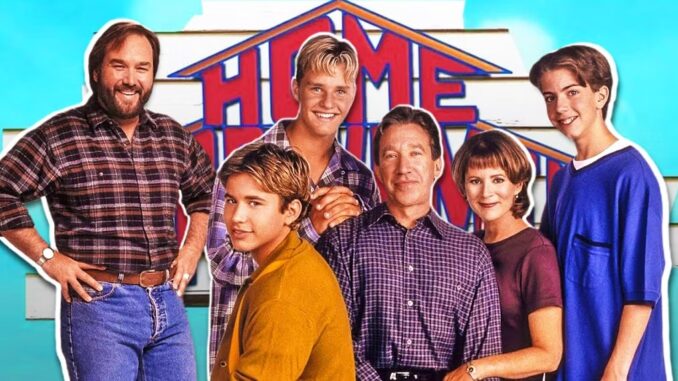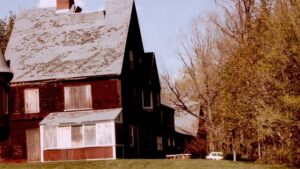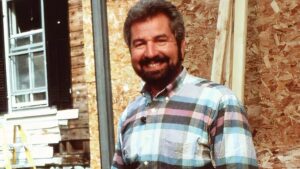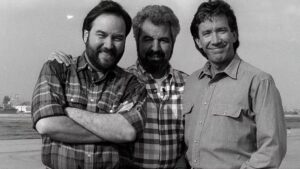
Before Home Improvement became a household name and Tim Allen earned fame as Tim “The Toolman” Taylor, there was another show laying the groundwork for his sitcom’s success: PBS’s This Old House. Debuting in 1979, This Old House sparked a wave of home renovation programming and, surprisingly, became the uncredited inspiration behind Home Improvement. While the link between the two shows may not be obvious at first glance, it turns out that Tim Allen’s Home Improvement owes much of its premise, aesthetic, and success to the pioneering renovation series.
The Origins of This Old House

This Old House is widely regarded as the original home renovation series, and its creation was the result of an unexpected stroke of genius. Producer Russell Morash, who had previously found success with The French Chef and other shows, was struck by a simple observation: people loved to watch construction and renovation in action. After seeing a crowd gathered around a construction site on a snowy day in Boston, Morash had an epiphany—if people were interested in watching construction live, they would be equally intrigued by the process on TV.
The show debuted on February 20, 1979, featuring the renovation of a Victorian home in Boston’s Dorchester neighborhood. Despite the pilot’s financial loss, This Old House became an immediate hit. The series coincided with a national energy crisis, and during the economic downturn, it became a lifeline for homeowners looking for ways to get the most out of their existing spaces. What started as a regional show soon went national, making This Old House an iconic part of television history.
How This Old House Changed TV Forever

While it didn’t invent the idea of DIY or renovation, This Old House undeniably popularized it. Over its four-decade run, the show became a blueprint for countless other renovation programs, even inspiring modern-day hits like Fixer Upper. Its success led to spinoffs, a This Old House magazine, and even a trade school for aspiring builders.
The show’s original hosts—Bob Vila, Norm Abram, Richard Trethewey, and Roger Cook—were a huge part of its success. Vila’s easygoing manner and expertise turned him into a household name, and Abram’s plaid shirts became iconic. But what really set This Old House apart from other shows was its educational approach. Rather than just showcasing finished projects, This Old House demystified the renovation process, giving viewers the tools to try things themselves or better understand how to hire professionals for their own home improvements.
Despite initial concerns from industry professionals who feared the show would cut into their business, This Old House actually had the opposite effect—viewers felt more confident hiring experts once they understood what went into the work.
The Connection to Home Improvement
Tim Allen’s Home Improvement, which premiered in 1991, owes much of its premise and structure to This Old House. In fact, Allen himself has admitted that This Old House was a major inspiration for the show, especially in terms of its setting and format. Originally, Allen envisioned Home Improvement as a mix of This Old House and a husband-and-wife dynamic inspired by the classic Thin Man films. The result was Home Improvement’s “Tool Time,” a fictional home renovation show hosted by Tim Taylor (Allen), alongside his trusty sidekick Al Borland (Richard Karn), who, in a tribute to This Old House, wore plaid shirts like Norm Abram.
In Home Improvement, Tim Taylor was a bumbling, yet lovable, host who often made hilarious mistakes on his own renovation show, while Al, the more serious and competent co-host, balanced out Tim’s antics. The dynamic between Tim and Al was a direct nod to This Old House, particularly the relationship between Bob Vila and Norm Abram.
The Show’s Tribute to This Old House
Not only did Home Improvement borrow the format and aesthetic of This Old House, but the two shows also shared a mutual respect. Vila, recognizing the homage being paid to him and Abram, even appeared as a guest on several episodes of Home Improvement. Similarly, Tim Allen guest-starred on Vila’s own renovation series, Home Again. This collaboration underscored the camaraderie between the two shows, despite their similarities.
In a 1991 interview, Vila himself commented on the resemblance, jokingly acknowledging that Home Improvement was essentially a sitcom based on him and Norm. But instead of taking offense, Vila embraced the connection, understanding that This Old House had inspired a cultural phenomenon.
The Lasting Legacy of This Old House and Home Improvement
Both This Old House and Home Improvement have left a lasting impact on TV and pop culture. This Old House is still airing today, almost 45 years after its debut, making it one of the longest-running TV series in history. Meanwhile, Home Improvement remains one of the most beloved sitcoms of the 1990s, influencing later family-centered TV comedies.
Though Tim Allen became the face of Home Improvement, it’s clear that without This Old House, Allen might never have had the idea to create the bumbling home improvement expert that became Tim “The Toolman” Taylor. The hidden connection between these two shows is a reminder that sometimes the simplest ideas, born from real-life inspirations, can lead to television history.
So, the next time you tune in to This Old House or revisit Home Improvement, you’ll know that the legacy of home renovation TV all started with Russell Morash’s chance encounter at a construction site in the 1970s. It’s a connection that continues to resonate decades later.

